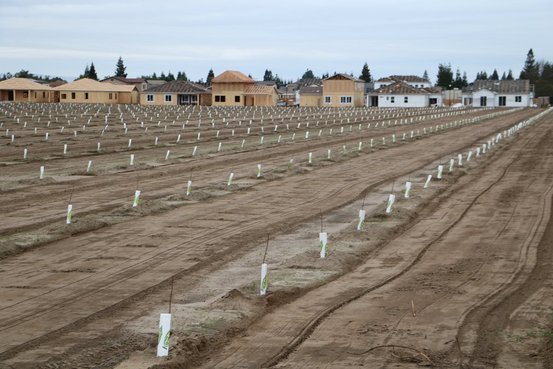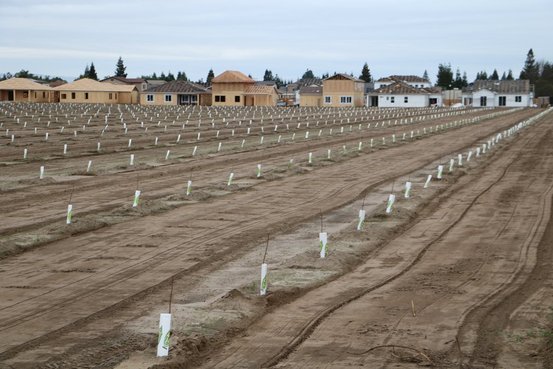I had this wild idea 14 months ago to create an outdoor reading area to take advantage of the cool afternoon breezes in my heavily shaded — and planted — front yard that a neighbor aptly refers to as a jungle.
I would mimic what I did at my last house. Remove dirt, painstakingly pound and level it and create a patio and walkway using bricks placed in a pattern using finishing sand.
Perhaps I should back up a bit.
There was a time when I got VIP treatment at nurseries for a 30-mile radius. It started with our home on Pine Street. When all was said and done I managed to plant 168 roses, 90 plus shrubs, who knows how many flowers, and 12 flats of gazinas to create a break between the sidewalk and the lawn on our corner lot.
The gazinas, in short order, ended up becoming an all-they-could eat buffet for gophers.
What inspired me to do it was simple. I hate cutting grass. The more lawn I could remove and re-plant with shrubs and such, the happier I am. I realize that conveniently glosses over the fact roses are a lot of work especially 168 of them.
But there are no gas fumes, ear-splitting noise, or common courtesy restrictions when you could work. It wasn’t unusual for me to squeeze in 15 minutes here and there doing work in the garden on top of obviously hellacious work days in the yard.
I’ve continued that trend of odd hours gardening at my current home often watering the yard at 2 a.m. with a headlamp.
Why, you might ask, don’t I just get an automatic sprinkler system?
Good question and I’ve got the answer. I ripped out all of the grass front and back. By doing watering once a week by hand I can direct it where it is needed and check for any issues.
At the same time I used a crowbar and sledge hammer to remove a good 7 yards of linear concrete sidewalk placed what I thought were in the wrong places. Hence, the idea of placing bricks — or pavers — with sand in case I wanted to change things out.
As for not using equipment such as a jackhammer, it is relaxing and rewarding in a way to do it by hand. It is also painstakingly slow which means you can relax your mind by devoting your attention to breaking up the concrete piece by piece.
Since moving in 13 years ago, I’ve altered plantings about three times before going with what works which is what John Alves calls the “jungle look.”
This brings me back to my front yard project. I spent an inordinate time looking a pavers and bricks before coming up with a design that would need two pallets of classic bricks to execute. I even set aside money for the project.
What happened next was simple. I wasn’t one of those people who can say the pandemic helped free up time for home improvement projects. My workload increased.
So two weeks ago I came up with the solution. I’d scrap the front yard idea especially since it did not offer much in the way of privacy in the winter, would have no cover against the rain should it ever return, and I’m more likely to learn to speak fluently in Latin before I got around to tackling it and trade it for the carport.
All I need were two patio chairs, a table and some vases with plants in them so it would not look like I was sitting in a carport.
Now you are probably wondering why I just don’t use the backyard that has a nice shade canopy thanks to 14 trees I crammed into it. Two reasons — Dante and Rascal. It is their yard. And no matter how much I love them they have it in their Dalmatian heads (Rascal is part pit bull) they were born to be 60-pound lap dogs. Also going sans grass in the backyard with two dogs isn't exactly conducive to creating an outdoor room.
As for the carport conversion, I’ve ordered the patio chairs and already picked up three “garden urns” I planted Sunday with ferns.
This probably wasn’t a good move as on recent jogs I’ve noticed a lot of people who have integrated flower/shrub containers in front yards and on their porches. With 168 roses as a reference point, one guess on where I’m likely headed.
I spent the better part of Sunday afternoon at Lowe’s Home Improvement looking at everything from stained concrete garden containers that weighed half my weight to ceramic garden urns with pricing more in line with my monthly car payment.
What I settled on was stunning and surprisingly inexpensive. They are made of resin with 30 percent recycled materials.
They are pleasant to look at, even more so with ferns planted in them.
As such I have decided to finally use two garden urns that were handed down to me that I have blocked off in my backyard in a secure manner to prevent the dogs from breaking them.
One is a glazed ceramic garden urn tipping the scales at 45 pounds that was a wedding anniversary present to my Grandmother Edna Towle in 1920. The other is a basic terra cotta urn that was given as a gift to my Grandmother Millie Wyatt in 1925.
Both were crafted and manufactured at Gladding, McBean & Co. in Lincoln, Placer County. The 146-year old manufacturing plant is devoted to churning out clay sewer pipe and roof tile today. But there was a time a dusty studio on the second floor of the main factory was where craftsmen toiled making terra cotta works of art.
Their handiwork included custom radiator caps for limousines in the 1920s, massive city seals that still grace city buildings in New York City, ornate terra cotta facades that are signature architectural features such as on the Wrigley Building in Chicago to the massive rainbow on the Waikiki Beach Hilton resort tower.
By such standards the urns are Plain Jane.
I found myself wondering why I‘ve never used the urns that, quite frankly, I’ve hidden away. I figured out I was worried I’d break them. But that made no sense. If I valued them that much, why wasn’t I using them?
I’m semi-notorious for not holding on to many things for purely sentimental reasons. If mini-storage owners relied on people like me they would be out of business.
So now the game plan includes adding the hernia inducing urns to my three lightweight purchases in the carport.
I’m actually a bit leery of doing it because of what might happen.
It’s not that I have a fear of them getting broken. It’s more a fear that a year from now I may find myself hip deep in garden containers in my carport.
But then again its less work than cutting grass or caring for 168 roses.
This column is the opinion of editor, Dennis Wyatt, and does not necessarily represent the opinions of The Bulletin or 209 Multimedia. He can be reached at dwyatt@mantecabulletin.com









